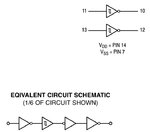Politecnico
Member level 1
Hi All

Regarding the attached diagram, to drive a N-channel Mosfet switch, what is the difference between using "combination of an inverting schmitt trigger & an inverting gate driver" and "combination of a non-inverting schmitt trigger & a non-inverting gate driver"?
I don't understand why many designers would prefer the inverting combination!
Thanks a lot for any hint, in advance
Politecnico

Regarding the attached diagram, to drive a N-channel Mosfet switch, what is the difference between using "combination of an inverting schmitt trigger & an inverting gate driver" and "combination of a non-inverting schmitt trigger & a non-inverting gate driver"?
I don't understand why many designers would prefer the inverting combination!
Thanks a lot for any hint, in advance
Politecnico

